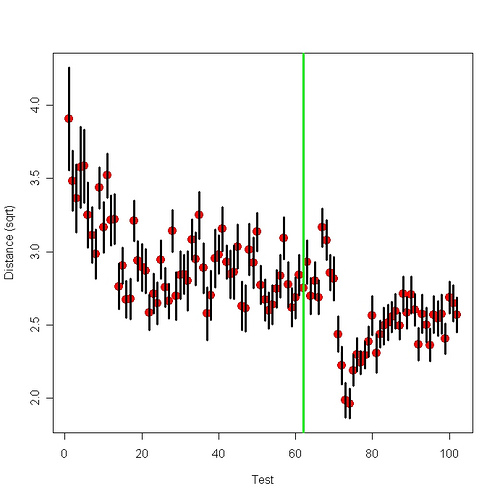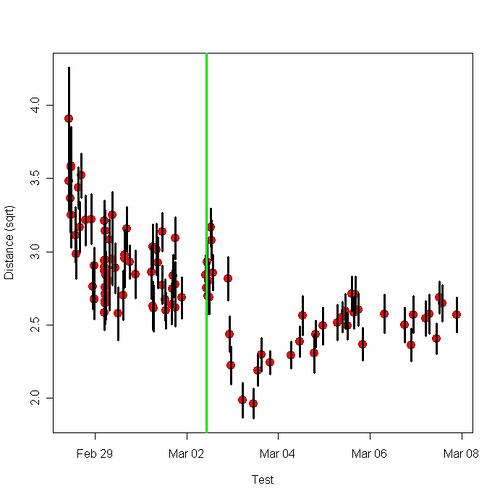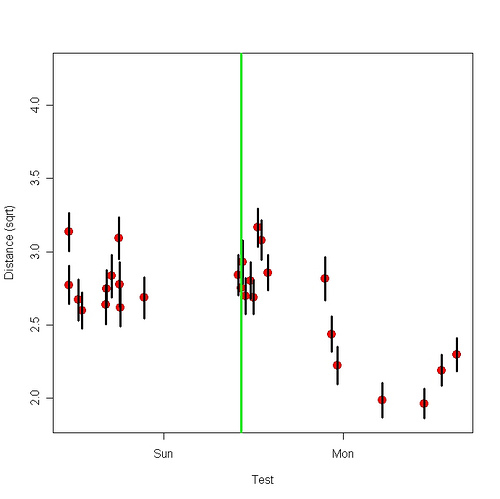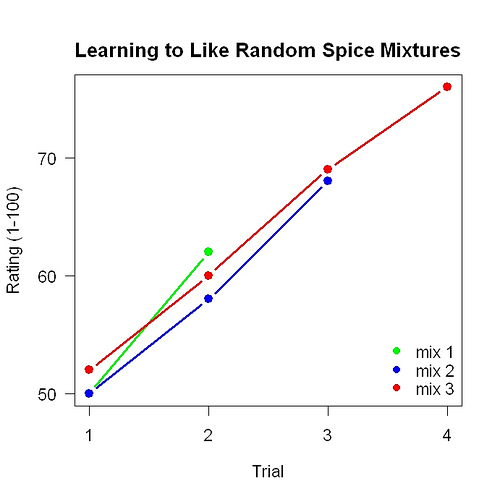Scientific American Online has started a eight-part series about self-experimentation. Part 2 is about Morgan Spurlock of Supersize Me.
Author: Seth Roberts
Science in Action: Omega-3 (motor-learning surprise)
The more I played racquetball, the more accurate my shots became — the more control I had. It was a kind of learning: learning to place the ball. I was fascinated by how little we knew about how that learning took place. I studied associative learning in my own research. The motor learning during racquetball resembled associative learning in the sense that my actions (hitting the ball with the racket) were shaped by what happened next (accuracy of placement). Yet I knew nothing non-obvious about motor learning.
This background of ignorance is why I find my latest flaxseed oil results so interesting. As I’ve posted, I’ve started using a new test in which I use the touchpad to “toss” the cursor from one spot to another (that is, move the cursor with a single finger movement), and measure how close it “lands” to the target. The function relating cursor position to finger position on the touchpad isn’t simple.
Of course I wanted to see how flaxseed oil affected performance on this task. I doubted that it would. This task is untimed. No time pressure. It is like shooting free throws. Most of the previous tasks I’ve used that have shown a flaxseed-oil effect have been tasks where you respond as fast as possible. My balance test was go at your own pace, but it involved a huge amount of computation. Balancing my body on one foot for several seconds seemed to involve a lot more computation than moving a finger about an inch.
Usually I take 4 tablespoons of flaxseed oil just before bedtime. One recent day I took it much earlier and did the toss test at 30-minute intervals before and for several hours afterward.
Here are the results plotted as a function of test session number.

Here are the same results plotted versus the time of the test:

Here is a close-up of the crucial data:

About two hours after I drank the flaxseed oil, my accuracy got worse. Then it slowly got much better. The amazing thing about the improvement is that it reached a maximum long after you would think that the effects of the flaxseed oil had worn off. My overall level of omega-3 is high because I take 4 T flaxseed oil per day. The effect of shifting when I drink the 4 T is just to change the timing of a short-lived peak. Usually that peak happens when I’m asleep and my omega-3 levels are reasonably constant while I’m doing the test. In this case the peak happened while I was doing the test.
I’ll discuss what this might mean in a later post.
Is LDL Bad Cholesterol?
You’ve heard a million times that there is “good” cholesterol (HDL) and “bad” cholesterol (LDL). Recently I got my cholesterol measured. My LDL was 151 mg/dl. The test results were written on a form that said your LDL should be “Below 100 mg/dl. Below 70 mg/dl if High Risk.” The person who handed the results to me said, “These are not the best results . . . ”
How concerned should I be? A 2005 study in the Journal of the American Geriatric Society surveyed several thousand “elderly people [who] were recruited from a general Italian population, and mortality was monitored from 1983 to 1995.” The emphasis of the study was on whether LDL was good or bad.
People with more LDL lived longer. You read that correctly. For women, mortality was lowest at the highest level of LDL. For men, mortality was higher at the highest level of LDL (60 deaths/1000 patient years) than at the next highest (50), but still lower than at the lowest level of HDL (90). Going from the lowest to the highest levels of LDL is associated with a one-third decrease in mortality, in other words.
What should I make of my 151 mg/dl? To convert to the units of the paper (mmol/L), I needed to divide by 39. 151/39 = 3.9. Looking at the graph relating mortality to LDL, an LDL concentration of 3.9 mmol/L is where the mortality vs LDL function reaches a minimum — the lowest mortality. According to this study, my LDL is optimal.
Thanks to Joel Kauffman.
Gary Taubes’ Influence on Me
Yesterday I had my cholesterol levels measured. My HDL was better than usual — I have ten years of records — and the Total Cholesterol/HDL ratio was good, which is unusual for me. Thinking about what might have caused this, I realized that over the past few months, mainly because of Good Calories Bad Calories, I’ve shifted toward what I think of as a pre-agricultural diet: plenty of meat and greens, no grains, a little fruit. Long ago I stopped eating packaged food. That was the pre-factory diet — a hundred years ago. Now I’ve moved back in time two more log units (log unit = factor of 10).
Calorie Learning: First Results
I made random flavors by mixing 4 randomly-chosen spice mixtures into butter. I spread the butter on 2 pieces of Wonder Bread. I used each mixture more than once — twice in a row (1st mixture), three times in a row (2nd mixture), four times in a row (3rd mixture). Each trial consisted of a flavor-calorie pairing — flavor from the spices, calories from the bread. Each trial also provided a rating, which measured the learning.
Here are the ratings of how good the bread tasted.

This was good. 1. The ratings started near 50 (neutral) each time. I’d like to have a large supply of flavors so that I can start fresh each time. These results suggest that randomly mixing 4 spice mixes provides this. The 4 spice mixes were randomly chosen from 10 spice mixes — so there are a lot of possible combinations. 2. The learning per trial was substantial.
More in the category Calorie Learning.
Yay, EW Popwatch!
A recent EW Popwatch post compared several YouTube versions of Leonard Cohen’s Hallelujah, much like I did here. It’s like Leno and Letterman telling the same joke. We have an Instinct of Connoisseurship, Veblen would say.
Useless Data and Me
Odd Numbers, an excellent blog by Jubin Zelveh at Portfolio.com, recently listed a few findings from the American Time Use Survey, which is in danger of being ended. They included:
– First-born children receive 20 to 30 minutes more quality time each day from parents than second-born children.
– Married couples have very little influence over each other when it comes to how much time each spends on leisure, child care, and chores.
A comment was:
Valuable information?
You can’t be serious. What can possibly be done by anybody about these “observations”?
This seems like a welfare program for economists.
Time use data — from 13 countries, including America — had a huge effect on my research and I suppose my life, since I applied my research to my life. The time use data I’m referring to showed that Americans were awake an hour later than people in the 12 other countries. They also watched TV an hour later. In other words, America was an outlier in two distributions: time of going to sleep, and time of stopping TV watching. I knew about research that showed that exposure to other people controls when we sleep. The time use data suggested that watching TV can substitute for ordinary human contact in the control of when we sleep. I wondered if seeing faces in the morning would improve my sleep; so I tried watching late-night TV early in the morning (via tape). I did that on a Monday morning. On Tuesday morning, I felt exceptionally good. Thus began the self-experimentation behind my pretty-face post. My best work. (The self-experimentation, not the post.)
Thanks to Marginal Revolution.
The New Yorker 2.0
I read this excellent article by Michael Lewis in the print version of Portfolio. Then I looked at it online. The online version was much better: It had reader comments.
When will The New Yorker online follow Portfolio‘s lead and allow comments? Comments on fiction should be especially interesting.
I suppose I’m especially sensitive to this issue. Spy had a regular feature called Letters to the Editor of The New Yorker. (At the time, The New Yorker did not publish reader letters.) I wrote two of them, here and here.
Pretty Life-Size Face
This site takes a few seconds to load and provides — once you zoom in — a pretty face close to life-size, which is what you need to get the mood effect I describe in Example 2 of my long self-experimentation paper. I usually use a mirror to get a life-size face but I will try this one instead.
Internet Addiction
… is likely to become a recognized psychiatric disorder via inclusion in the next edition of the DSM (Diagnostic and Statistical Manual) of the American Psychiatric Association. From an editorial about it:
[There are] at least three subtypes: excessive gaming, sexual preoccupations, and e-mail/text messaging. All of the variants share the following four components: 1) excessive use, often associated with a loss of sense of time or a neglect of basic drives, 2) withdrawal, including feelings of anger, tension, and/or depression when the computer is inaccessible, 3) tolerance, including the need for better computer equipment, more software, or more hours of use, and 4) negative repercussions, including arguments, lying, poor achievement, social isolation, and fatigue. . . Some of the most interesting research on Internet addiction has been published in South Korea. After a series of 10 cardiopulmonary-related deaths in Internet cafés and a game-related murder, South Korea considers Internet addiction one of its most serious public health issues . . . . The average South Korean high school student spends about 23 hours each week gaming.
Stop reading this!